The Journal of San Diego History
SAN DIEGO HISTORICAL SOCIETY QUARTERLY
Summer 1990, Volume 36, Numbers 2 & 3
![]()
Introduction | Chronology | Arts & Crafts | The Marstons | Hebbard & Gill
Marston House | Walking Tour | Marston Garden
Notes by Bruce Kamerling
 |
Key to Map:1. George White & Anna Gunn Marston Residence 2. Dr. Frederick & Lilla Burnham Residence 3. Arthur & Elsa Marston Residence 4. Alice Lee Cottage 5. Alice Lee Residence 6. Katherine Teats Cottage 7. Mrs. Sarah M. Elston Residence 8. Lorenze & Miriam Barney Residence 9. George & Anna Barney Residence 10. Rev. Frederick & Mary Cossitt Residence 11. Thomas & Margaret Hamilton Residence |
The 3500 block of Seventh Avenue is part of the subdivision known as Thomas T. Crittenden’s Addition, which he filed in 1887. This short block contains important examples of Arts & Crafts Period architecture by four of San Diego’s most prominent architects: Irving Gill, William Hebbard, Frank Mead and Richard Requa. Additionally, several other notable architects worked on these homes including Louis Gill, Hazel Waterman, and Emmor Brook Weaver.
Among the unusual features of the street are the light standards, which are different than those found elsewhere in San Diego. Electricity did not become available in this part of town until a number of years after George Marston built his home. He installed a generator and supplied all of his neighbors with power until the utilities arrived. He may have installed the street lights as well. Marston’s generator also serviced his two electric automobiles which had to be recharged every 100 miles.
The rock for the sandstone retaining walls in front of some of the houses came from Linda Vista. Originally, pepper trees lined the street, but these were later replaced with jacarandas. A curbing scheme dates to May 1914, about the time the street was paved. Pink tinted sidewalks can still be found in some sections. This color had been recommended by Kate Sessions, San Diego’s famous horticulturist, who did not like the glare of concrete. Many sidewalks in the Burlingame area east of Balboa Park have a similar tone. About 1932, Seventh Street was renamed Seventh Avenue, which amused the residents of this small section of the street.
Enjoy your stroll, but please remember… These are private residences. Please respect the owner’s property and privacy. Stay on the sidewalk!
Dr. Frederick & Lilla Burnham Residence (1906)
3565 Seventh Avenue, (private drive; do not enter without permission)
William Hebbard & Irving Gill, architects
San Diego Historical Site #41
In March of 1906, George Marston sold one third of his ten acre parcel to his sister and brother-in-law, Lilla and Frederick Burnham. The Burnhams immediately hired Hebbard and Gill to be the architects for their new home, with Irving Gill as designer. Working drawings for the house date from March to April of 1906. In June of that year, the City issued a building permit for a $16,000 residence.
Although still reminiscent of Hebbard and Gill’s earlier work, the Burnham house makes a break with the English Cottage tradition. The influence of the Midwest Prairie Style is strongly in evidence. The low pitched roof, broad eaves, boxey appearance and linear quality of the half-timbering lend a feeling of modernity to the brick structure. Originally, all of the windows were mullioned casement type with ventilators above. The basement featured a billiard room with tile wainscot, and Gill made extensive use of natural woodwork on the main floor.
Samuel Parsons & Company drew up the landscape plan for the Burnham property. Parsons served as president of the American Society for Landscape Architects and acted as consulting architect for the park system of Greater New York. He had first come to San Diego in 1902 at the request of George Marston to draw up a plan for Balboa Park (at that time known simply as City Park). The first plantings at the house took place in 1907 and 1908.
Frederick Burnham served as a harbor commissioner, as president of the Board of Education and Board of Health, and also served as a director of the Y.M.C.A.. In 1948, after the death of Mrs. Burnham, daughters Katherine Ostrander and Lilla Barney bought out the interests of their brother Marston Burnham and sister Theda Boynton, and returned to live in the family home. At that time the main entrance was changed to the north side of the house to be closer to the central staircase, each sister having a separate floor.
George Marston’s other sister, Mary White Marston married Michael Kew, an attorney. In 1912, the Kews hired the famous architect brothers Charles and Henry Greene of Pasadena to design a large English style home for them at Sixth Avenue and Spruce Street. Now demolished, this was the only building the architectural firm of Greene and Greene ever designed in San Diego.
 Although the basic shape of the Burnham house is rather simple and boxey, Gill enlivened the surface by using simple linear half-timbering on the second floor.
Although the basic shape of the Burnham house is rather simple and boxey, Gill enlivened the surface by using simple linear half-timbering on the second floor.
 In 1912, the famous Pasadena architects Charles and Henry Greene designed the Michael and Mary Kew house for George Marston’s sister and brother-in-law.
In 1912, the famous Pasadena architects Charles and Henry Greene designed the Michael and Mary Kew house for George Marston’s sister and brother-in-law.
Arthur & Elsa Marston Residence (1909)
3575 Seventh Avenue
Irving Gill, architect
George Marston sold this property to his son Arthur, vice-president of the Marston Company, and daughter-in-law in April of 1908. The younger Marstons hired Irving Gill, no longer in partnership with William Hebbard, to design the house. The working drawings are dated April of 1909, and a Notice of Completion was filed on December 27 of that year.
Gill produced several different studies for this house, possibly indicating that the architect and client had trouble agreeing on a design. At this time in his career, Gill worked primarily in a modern stripped-down style with smooth stucco walls. The Marston family, however, had always preferred red brick houses. The resulting design shows typical Gill features such as the boxey shape, casement windows, and recessed arched entry, adapted to a red brick structure.
In 1929 and 1930, Irving Gill’s nephew, Louis Gill, who had been his partner from 1914 to 1919, designed a north wing addition and the separate garage with apartmnent above. The pergola in front is a recent construction.
 This view of the Arthur Marston house taken about 1924 shows the Burnham house in the distance. Gill liked the privacy of a recessed side entrance, and preferred using casement type windows for better ventilation.
This view of the Arthur Marston house taken about 1924 shows the Burnham house in the distance. Gill liked the privacy of a recessed side entrance, and preferred using casement type windows for better ventilation.
 Gill produced several presentation renderings for the Arthur Marston house. Most of these show a stucco structure, but the Marstons preferred red brick. (Photo courtesy University of California Santa Barbara).
Gill produced several presentation renderings for the Arthur Marston house. Most of these show a stucco structure, but the Marstons preferred red brick. (Photo courtesy University of California Santa Barbara).
Alice Lee Residence (1905)
3574 Seventh AvenueKatherine Teats Cottage (1905)
3560 Seventh Avenue (south cottage)
San Diego Historical Site #98Alice Lee Cottage (1905)
3578 Seventh Avenue (north cottage)
San Diego Historical Site #99William Hebbard & Irving Gill, architects
Alice Lee came to San Diego in 1902 from a family long established in real estate development. Her talent for community planning helped create the model town of Westport, New York, situated on property her family owned along the shores of Lake Champlain. She purchased the Seventh Avenue property from Thomas Crittenden in May of 1903, and engaged the services of Hebbard and Gill late in 1905. Of the three houses, drawings survive for the Teats cottage only, and these are dated November of 1905.
Hazel Waterman assisted Hebbard and Gill on this project as the draftsperson for the Teats house and possibly the other two as well. Hebbard and Gill designed a home for Waldo and Hazel Waterman in 1900, and Gill was impressed with her ability to understand architectural concepts. After the death of her husband in 1903, she took a correspondence course in architectural drafting and worked on several Hebbard and Gill projects. The Wednesday Club (1911), a few blocks away at Sixth and Ivy Lane, remains one of her finest independent designs.
In his later career, Gill became known for his innovative multiple residential designs, and the Lee and Teats houses appear to be his first experiments in that area. Originally one piece of property, these three houses were connected by a U-shaped pergola around a shared garden (this pergola still connects the two Lee houses). The low profile and emphasis on the horizontal show the influence of the Prairie Style which was just becoming popular in the Midwest. Gill encountered this style on trips to supervise construction of houses in Maine and Rhode Island. The Lee and Teats houses appear to be the first Prairie Style buildings constructed in San Diego.
Building permits were issued late in 1905 for a $5,000 residence and two $3,500 cottages. The houses were constructed in 1906. In May of 1906, Alice Lee granted the property of the Teats Cottage to her companion Katherine Teats. Misses Lee and Teats lived in the main house and used the other two for rentals. Miss Lee was close friends with both Mrs. Grover Clevelend and Mrs. Theodore Roosevelt, and often dined at the White House. President and Mrs. Roosevelt, Mrs. Cleveland, and other distinguished visitors were often guests at Miss Lee’s Seventh Avenue home.
In 1911, Gill enlarged the Lee cottage (on the right) extending the building to the north to create room for a basement garage down the slope, a dining room on the first floor, and a bedroom and bath on the second floor. These alterations may have been done to accommodate the family of architect and engineer Frank P. Allen, Jr., who resided here from 1911 to 1915. Allen came to San Diego to work with Bertram Goodhue and Irving Gill as Director of Works for the Panama-California Exposition (1915). The magnificent Cabrillo Bridge leading into Balboa Park is probably his most famous design in San Diego. Alice Lee sold this property to Dr. Anita Muhl in 1925.
The Katherine Teats cottage was altered by Irving Gill in 1912 and again by Louis Gill in 1922. These changes enclosed the porch to the south and extended the second story over it. Katherine Teats sold the property to Henry and Ellen Babcock in 1923.
In 1912, the Misses Lee and Teats hired Gill to design a group of houses around a canyon bounded by Front and Albatross Streets south of Walnut. These shared a common garden with paths through the canyon.
 The Lee and Teats houses originally faced a common garden surrounded by a “U” shaped pergola which connected the three structures. This photograph shows the Teats house on the left before the south elevation was modified.
The Lee and Teats houses originally faced a common garden surrounded by a “U” shaped pergola which connected the three structures. This photograph shows the Teats house on the left before the south elevation was modified.
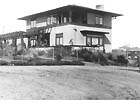 The Lee Cottage originally had an open sleeping porch on the southeast corner. In 1911, Gill designed an addition which extended this house to the north creating a garage, dining room and bedroom.
The Lee Cottage originally had an open sleeping porch on the southeast corner. In 1911, Gill designed an addition which extended this house to the north creating a garage, dining room and bedroom.
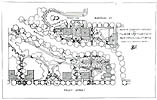 Beginning in 1912, Irving Gill, and later his nephew Louis Gill, designed a number of houses for misses Lee and Teats along a canyon between Albatross and Front Streets. Frank Lloyd Wright’s son, Lloyd Wright, worked for Gill in the early 1910s and drew this plan.
Beginning in 1912, Irving Gill, and later his nephew Louis Gill, designed a number of houses for misses Lee and Teats along a canyon between Albatross and Front Streets. Frank Lloyd Wright’s son, Lloyd Wright, worked for Gill in the early 1910s and drew this plan.
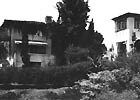 The Canyon House plans included gardens and walks that were to be shared by all the tenants. This photo taken about 1933 shows how nicely the landscaping had matured below two of the cottages Gill designed for Katherine Teats.
The Canyon House plans included gardens and walks that were to be shared by all the tenants. This photo taken about 1933 shows how nicely the landscaping had matured below two of the cottages Gill designed for Katherine Teats.
Mrs. Sarah M. Elston Residence (1908)
3536 Seventh Avenue
architect unknown
Of all the houses on this street, the least is known about this one. It was built for Sarah Elston who lived in it until 1919. From 1929 to 1937, Terry and Frances Barker owned the house. (In 1912, Irving Gill had designed a home for Terry Barker’s father, Nelson Barker, on Walnut Street.) From 1938 to 1960, the house was occupied by John P. Dexter, whose family founded Lakeside in 1886.
The Craftsman Style of the house, with its bracket eave supports, cut-out porch rail, and clapboard and shingle siding, was more apparent when the house had a stain finish. The off-set entry and asymmetrical bay windows lend interest to the front elevation
 A photograph of the Sarah Elston house taken during the years that is was owned by Terry Barker and his wife Frances (pictured) shows the original stained shingle finish.
A photograph of the Sarah Elston house taken during the years that is was owned by Terry Barker and his wife Frances (pictured) shows the original stained shingle finish.
George & Anna Barney Residence (1911)
3530 Seventh Avenue
Pacific Building Company, designers and buildersLorenze & Miriam Barney Residence (1913)
3534 Seventh Avenue
Frank Mead & Richard Requa, architects
Founded in 1906, the Pacific Building Company provided clients with both the architectural design and actual construction of homes and other buildings. Some of Gill’s draftsmen went to work for this firm, and his influence is discernable in the George Barney residence. Both Frank Mead and Richard Requa had also worked for Gill, Mead as partner in 1907, and Requa as superintendent from 1908 to 1910. Mead had studied indigenous architecture in North Africa as well as Pueblo Indian architecture in the American Southwest, and these influences are strong in the Lorenze Barney house.
George Barney wintered in San Diego from Omaha before moving here in 1906. He became a real estate developer and was known as the “Father of Mission Beach” which he planned and directed for over twelve years. He also headed the syndicate which built the Sandford Hotel downtown.
Lorenze Barney, son of George Barney, also became a real estate developer, and with his brother Philip established the Barney & Barney Insurance Company. Both Lorenze and his wife Miriam were deeply involved with the California Pacific International Exposition held in Balboa Park in 1935-36. He provided the insurance for the fair, and his wife served as chair for the Women’s Committee. The Lorenze Barneys left the neighborhood about 1920, but in 1940 he purchased his sister’s interest in the George Barney residence and lived there until his death in 1963.
Philip Barney married Lilla Marston Burnham, George Marston’s niece. They lived with Philip’s parents at 3530 Seventh Avenue for a time.
Richard Requa and Herbert Jackson made some alterations to the Lorenze Barney house in 1921. Recently, a second story was added and the entrance was changed from the north side of the house to the south.
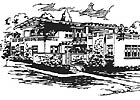 This architect’s rendering of the George Barney residence accompanied an article about the house in the San Diego Union of November 12, 1911. It shows that several changes were made in the house’s design before construction.
This architect’s rendering of the George Barney residence accompanied an article about the house in the San Diego Union of November 12, 1911. It shows that several changes were made in the house’s design before construction.
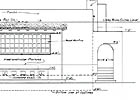 Mead and Requa’s original drawings for the Lorenze Barney residence show a structure strongly influenced by Gill’s latter stripped-down style.
Mead and Requa’s original drawings for the Lorenze Barney residence show a structure strongly influenced by Gill’s latter stripped-down style.
Rev. Frederick & Mary Cossitt Residence (1906)
3526 Seventh Avenue
William Hebbard & Irving Gill, architects
San Diego Historical Site #97
Frederick Cossitt served as rector of Christ Episcopal Church in Coronado. In 1896, Gill designed a house for the Cossitts in Coronado (this has since been moved and divided into two separate homes). Later, Hebbard and Gill designed two additional houses in Coronado for them as rentals. Mary Cossitt purchased the Seventh Avenue property from George Marston in July of 1906, and immediately hired Hebbard and Gill to design yet another house, this one to be their permanent residence. Rev. Cossitt died in 1911, and Mary and daughter Helen were last listed at this address in 1913. Mary sold the property to Dr. Bernard & Anna O’Neill in 1918.
Strongly influenced by the Prairie Style, this is one of the first buildings to show the modern trends that Gill’s later work would take. He designed it as a series of receeding and enlarging cubic shapes with broad flat eaves. The interior features a large englenook and extensive use of redwood paneling.
In 1910, Mary Cossitt commissioned Gill to design four more rental houses. These are still standing on Eighth Avenue south of Robinson, and are in Gill’s severe stripped-down style based on the cube relieved by arches.
 The entrance hall of the Cossitt house featured glass doors leading into the living room, and extensive use of redwood board and batten paneling.
The entrance hall of the Cossitt house featured glass doors leading into the living room, and extensive use of redwood board and batten paneling.
 In this view of the south side of the Cossitt house, Gill’s stepped treatment becomes apparent. Beginning with the englenook, the house enlarges into a living room with high ceiling and clerestory windows, and finally into a two story structure.
In this view of the south side of the Cossitt house, Gill’s stepped treatment becomes apparent. Beginning with the englenook, the house enlarges into a living room with high ceiling and clerestory windows, and finally into a two story structure.
Thomas & Margaret Hamilton Residence (1908)
3500 Seventh Avenue (demolished)
Irving Gill, architect
Thomas Hamilton’s father, Charles Hamilton, married Anna Marston’s sister, Elizabeth Le Breton Gunn. George Marston’s former partner, Charles founded Hamilton’s, Ltd., an exclusive grocer. The Thomas Hamiltons lived on Seventh Avenue from 1908 to 1910, when the house became the property of Mary White Fulford, a cousin of George Marston.
An early example of Gill’s later stripped-down style, the house contained a covered central court that was enclosed on all four sides. Because of this unique “garden room,” The Craftsman magazine published an article about the house in February of 1915. An arcade surrounded the court and provided the only access between rooms. Considered the main room of the house, the garden court included furniture, carpets, a wall fountain, and a copper wire fly-screen cover. The arcade could be curtained off into additonal rooms if needed to accommodate guests.
In 1913, Mrs. Fulford constructed three large Swiss Chalet style bunaglows in Burlingame east of Balboa Park. Designed by Carleton M. Window, assisting architect for the 1915 Panama California Exposition, all three houses are now locally listed Historial sites.
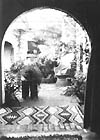 Gill created a garden court in the center of the Hamilton house that was considered to be quite a novelty in its day.
Gill created a garden court in the center of the Hamilton house that was considered to be quite a novelty in its day.
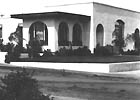 The low horizontal profile of the Hamilton house is typical of Gill’s later work. Plain simple shapes relieved by arches became a trademark of his style.
The low horizontal profile of the Hamilton house is typical of Gill’s later work. Plain simple shapes relieved by arches became a trademark of his style.







